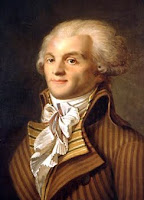 Last night I watched a Netflix/History Channel documentary on the French Revolution .
Last night I watched a Netflix/History Channel documentary on the French Revolution .
The French Revolution must have impacted “our” time period. The English aristrocracy must have looked with horror upon the events of the Revolution, especially the Reign of Terror during which 16,000 to 40,000 people were guillotined.
Knowing what happened during the French Revolution helps me understand the draconian measures the British Parliament invoked during the social unrest after the Napoleonic Wars–suspension of habeas corpus, the Seditious Meetings Act, the restrictions on newspapers, etc.
(The conflict between social justice and social stability was essentially the conflict between my heroine and hero in Chivalrous Captain, Rebel Mistress, by the way.)
 Random thoughts after watching the documentary:
Random thoughts after watching the documentary:
1. Something had to give. The disparity between the suffering of the poor and the excesses of the monarchy were too great. Desperate people do desperate acts. I cannot blame the French people for the revolt, nor the French people’s pride in seizing control of their fates.
2. Helping to fund the American Revolution helped to bankrupt France and led to the suffering of the French poor. How ironic is that?
 3. There was a mix of altruism and fanaticism in the Revolution. Marat seemed to always have been a fanatic, spurred on by his own internal rage, having little to do with reality. Robespierre seems to have been an idealist who was corrupted by his own power.
3. There was a mix of altruism and fanaticism in the Revolution. Marat seemed to always have been a fanatic, spurred on by his own internal rage, having little to do with reality. Robespierre seems to have been an idealist who was corrupted by his own power.
4. I don’t like Marat. He gratified his need to be important by stirring up the people with plots and conspiracies which did not exist. Ironically, his murderer, Charlotte Corday who only wanted to stop Marat’s influence, made him a Revolutionary icon.
5. How did the Revolutionary heroes like Robespierre justify the Reign of Terror? Even 16,000 people executed is a massive number. And how could he justify killing men who were once allies, just because they disagreed with him? (of course, he wasn’t the only one in history to do this…)
 6. How scary it must have been for even ordinary people at the height of the Reign of Terror. It seemed like almost anyone could get a person guillotined just by saying they were against the Revolution.
6. How scary it must have been for even ordinary people at the height of the Reign of Terror. It seemed like almost anyone could get a person guillotined just by saying they were against the Revolution.
7. Robespierre sealed his own fate. When those close to you fear that they are next on your list, you rise to number one on their list!
8. I feel sorry for Marie Antoinette. Surely she had no power and no understanding of what the lives of the poor were like.
Do you have any random thoughts about the French Revolution? What do you think was its affect on the Regency?
Remember. I’m blogging at Diane’s Blog on Thursdays.
And be sure to visit the new Harlequin Historical blog on eHarlequin.



 he great turning point for the Regency was the French revolution. Just as we feel now, that history has been made and a new era is beginning, people then might remember where they were when they heard about the fall of the Bastille. The French revolution was the wakeup call of its day, a source of inspiration and hope.
he great turning point for the Regency was the French revolution. Just as we feel now, that history has been made and a new era is beginning, people then might remember where they were when they heard about the fall of the Bastille. The French revolution was the wakeup call of its day, a source of inspiration and hope.



